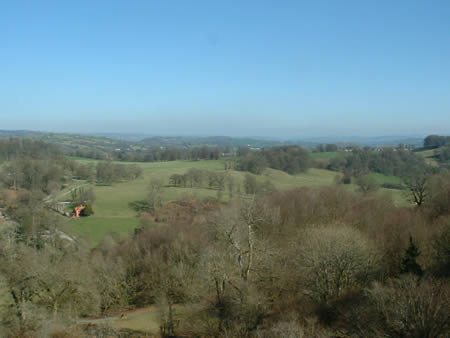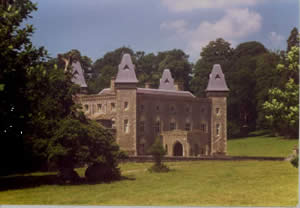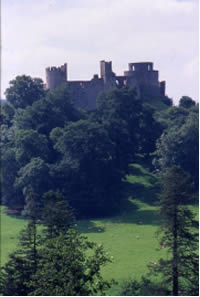Dinefwr Park
Introduction
The Property
Dinefwr Park is a remarkable property of exceptional significance for its archaeology, history, designed landscape, ecology, geology and buildings. Within the park are two Roman forts; a medieval castle linked to an illustrious phase of Welsh history; two medieval towns; the best example of ancient wood pasture in Wales; rare assemblages of lichens and insects; dead-wood fauna; a deer park; a designed landscape associated with ‘Capability' Brown; an 18 th century farm complex; a church; a mansion and a herd of White Park Cattle. Many of these features are subject to protective designations both statutory and non-statutory.

The park walls abut the west side of Llandeilo, Carmarthenshire. The Afon Tywi marks the southern limit, with the recently-constructed by-pass cutting through the original northern boundary (Map 1). It is one of a series of historic parks, houses and castles occupying the river valley between Llandovery and Carmarthen.
The forts and medieval towns were discovered through geophysical survey and documentary research. There are no surface remains. Overlooking the park and the river valley is the strategically-located castle. Seen from within the property it presents a dramatic silhouette against the southern sky. Veteran trees, with their communities of rare lichens and beetles, dominate the park. In the 18 th century these provided the framework for a designed landscape that combined recently-farmed land with a much older deer park. Clumps of trees, typical of the period, overlook the eastern part of the property and the surrounding countryside. The mansion, Newton House, acts as a focus. Originally constructed in the 17 th century it was encased in a Venetian-gothic façade in the 1850s. Home Farm was established in the 18 th century when the designed landscape was laid out.
Dinefwr Park reflects continuity, integration, interaction, identity and aesthetic appeal. There are many aspects to the widely recognised significance of this landscape but all are interdependent; the designed landscape was a success because of the back-drop of ancient trees. It is an excellent example of the continuum that exists between the natural and the historic environment. Dinefwr has evolved from a representation of political power, to an agricultural landscape and, finally, to a work of art that is also an island of rare and declining habitats. It is, and always has been, enjoyed and appreciated by visitors and the local community alike.
National Trust Ownership and Involvement
After five centuries of continuous ownership by the Dynevor family the estate was dispersed in the middle of the 20 th century. The National Trust acquired the Deer Park and part of the outer park in 1987. Recognising that sympathetic ownership is the most effective way of ensuring long-term survival the National Trust instigated a strategic programme of gradual acquisition of the remainder of the park. Newton House was purchased in 1990 having been through several hands since first sold by Lord Dynevor in 1976. East Drive was acquired in 1992 and the generosity of the Heritage Lottery Fund facilitated the purchase of Home Farm, which includes part of the original park, in 2002. The National Trust holding is now is now 194.9 ha in extent (Map 2).
Funds made available by the Heritage Lottery fund also made possible the acquisition of the Dynevor Collection of paintings. These include portraits, landscapes and a series of four remarkable views showing the park and house in the early decades of the 18 th century. These are displayed in Newton House. (photos 8&9)
Fishing rights are shared between Lord Dynevor and the Millbank estate. The Wildlife Trust South and West Wales have sporting rights over the meadows and part of the Lower Park
Dynevor is the name of the baronetcy and this spelling appears on many maps. In recognition of the importance of the site to Welsh history, the National Trust has opted for the Welsh version when referring to the park. The family name was Rice but in 1917 the 7 th Lord Dynevor applied to change the surname to the Welsh version: Rhys.
The conservation polices adopted by the National Trust within the park have aimed at maintaining and improving habitats, and the communities they support. Dead and dying wood is left in situ and, following consultation with internal advisers, a phased programme of tree planting has been undertaken. The National Trust has worked closely with the Countryside Council for Wales on shared objectives to maintain and enhance features of nature conservation and geological interest. The herd of White Park Cattle, sold by Lord Dynevor in 1976, was brought back in 1992. A ‘little and often' approach has seen the gradual repair and consolidation of several estate buildings. The assistance provided by volunteer labour has been invaluable and Dinefwr has consistently contributed to the training needs of the area.
Since acquisition access has been seen as a priority but this has had to be balanced against the needs of conservation and preservation. Access to the Deer Park was restricted to a viewing point on Cae lan until 2001 when a way-marked path, partly funded by Carmarthenshire County Council, was set out. A board walk through Bog Wood and around Mill Pond was built in 1995 to provide access for all.
Newton House was in poor condition when acquired. Extensive refurbishment was undertaken involving the replacement of many fixtures. This was funded by a variety of sources including the European Regional Development Fund, the Wales Tourist Board, the Welsh Development Agency, Dyfed County Council (as was) and private benefactors. The Fountain Garden had been turfed over. It was uncovered and partially restored in 1997. Visitor facilities were erected in the car park located to the south-east of the house and the dining room was converted into a tea room. The basement, ground floor and some of the first story were opened to the public in 1998. Access to the house is made possible through the dedication of an active group of volunteers

Since 1994 Newton House has functioned as a place to inform visitors about the history of the estate and provide refreshment. The two top floors were to have been let as offices to provide revenue for the maintenance of the building and park. However, a suitable tenant could not be found and the rooms have lain empty whilst alternative, affordable uses were explored. In the meantime a number of community and income generating uses have evolved including seasonal exhibitions, events and weddings.
Interpretation has been provided in two locations. Exhibition boards in the basement explain the history and significance of the castle, house and landscape. Information on the natural history has been provided in the Slaughter House. Dinefwr features frequently in wider promotional and educational literature produced by the National Trust. For instance there is a section on the property in the recently published book on Parks. Dinefwr also features in numerous scholarly books and articles covering both the medieval history of Wales and the 18 th century landscape movement.
The National Trust has sought to work in partnership with other owners. Visitors to Dinefwr Castle use the National Trust car park and walk up to the site. The warden has engaged actively with the Wildlife Trust South and West Wales to ensure an integrated and holistic approach to the management of the park.
The Wildlife Trust South and West Wales
2.3.1 The Wildlife Trust South and West Wales acquired South Lodge Woods, Church Woods and Castle Woods in 1976 (Map 2). Castle Woods includes Dinefwr Castle though the site is a guardianship site and managed by Cadw. Llandyfeisant Church is the property of the Church in Wales but is leased to the Wildlife Trust who previously used it as an interpretation centre.
Cadw
 The dramatic silhouette of Dinefwr Castle overlooks the southern part of the park
The dramatic silhouette of Dinefwr Castle overlooks the southern part of the parkDinefwr Castle, in state guardianship since 1996, is managed and maintained by Cadw on behalf of the National Assembly of Wales (Map 2). Cadw commenced a programme of conservation in 1982 and has undertaken detailed surveys of upstanding masonry and the outlying earthworks. Research into the medieval history of the site enabled the production of the guidebook prior to the opening of the castle to the public with site information panels to interpret the castle for the visitor. Conservation of the castle, now complete, was designed to have minimal intervention into historic masonry and to be non-intrusive archaeologically. Accordingly excavation within the castle has been minimal and there remains considerable potential for further excavation, geophysical and documentary research.
Private Ownership
To the south of Newton House are two enclosed courtyards, a dovecote, paddock, walled garden and Dairy Cottage. These are divided between two owners who have a right of access by means of the East Drive. Pen lan, immediately to the south of the entrance to the park, is also in private ownership. Carmarthenshire County Council has possession of the south eastern corner of the park and Llandeilo Rugby Football Club own the north eastern corner. The second walled garden, which abuts Home Farm, is in private ownership (Map 2). East Lodge, South Lodge, Kings Lodge and Mynachdy (Keeper's Lodge) were sold as separate lots when the estate was dispersed.
The Dinefwr Project
In 2000 The Dinefwr Project was initiated with aim of restoring and providing access to the designed landscape. Parts of the park had been subjected to an intensive agricultural regime and have lost many elements, if not all, of the original design. The remainder of the park is superficially in good condition though there are several modern anachronisms. It is however fragile, and vulnerable to both internal and external factors. For instance the veteran and mature trees, that are key to the success of the park, could be severely damaged by an extreme event such as a storm or deteriorate gradually because of inappropriate management.
Phase One of the Dinefwr project has been funded by the Heritage Lottery Fund to include acquisition of Dynevor Home Farm and Pen parc, conservation, restoration, management and business plans, and emergency repairs.
Aim of the Conservation Plan
The conservation plan aims to inform the consolidation, restoration and management of the designed landscape. By understanding the issues, describing significance, identifying vulnerabilities and listing appropriate policies it will ensure that no conservation issue is compromised or threatened. Future management will be guided by the information contained within the plan.
It will provide the means of explaining decisions concerning the park and buildings to the Heritage Lottery Fund.
The conservation plan will also be the means of disseminating the significance of the property both within Cadw, the National Trust, the Wildlife Trust South and West Wales and externally.
Scope of the Conservation Plan
Dinefwr Park is a historic unit and, therefore, the surveys commissioned by the National Trust as part of the conservation plan cover those parts of the park in other ownership to a greater or lesser degree. The chapters on significance, vulnerabilities and policies refer only to land owned or managed by the National Trust, Cadw and the Wildlife Trust, partners in this conservation plan.
The plan follows Heritage Lottery Guidelines including Commissioning a Conservation Plan and Conservation Plans for Historic Places.
The plan summarises surveys undertaken in the 1980s and 1990s. Further surveys were undertaken between November 2002 and June 2003 as part of Phase One of the Dinefwr Project. These aimed to improve our understanding of the property and were funded by the Heritage Lottery Fund, the Countryside Council for Wales and the National Trust. Copies of the major surveys are provided in the appendices together with a bibliography. The contractors worked as a team with National Trust property staff and advisers to ensure a coherent narrative and to identify principal significances.
The policies were written in consultation with National Trust staff and advisers. Hal Moggridge (Colvin and Moggridge) provided advice as to the restoration of the designed landscape and Neville Fay (Treeworks) made recommendations as to the future management of the trees.
Consultation
The entire plan was sent out for consultation in June 2003 and again in October 2003.
National Trust consultees included:
- Property Staff : Bob Hockey, Paul Faulkner, Brian Hancock
- Conservation Directorate : Jane Gallagher, Edward Diestelkamp, Madelaine Abey-Koch, Stephen Kane, Margaret Evans, Tim Knox, Rob Woodside, Bill Malecki, Julian Gibbs, Chris Lambart, John Harvey, Helen Buckingham, Alex Wigmore, David Griffiths, Rob Jarman
- Customer Services : Pauline Edwards, Gwynn Angell Jones, Selina Carpenter, Dilys Wynn Jones, Delyth Phillipps
- Finance, Planning and IT : Grahame Jones
External Consultees included:
- Cadw ( Sian Rees, Andrew Hood, Mial Watkins)
- Wildlife Trust South and West Wales (Derek Moore, Lin Gander, Madelaine Havard, Barry Downes)
- Countryside Council for Wales (Ian Morgan, Nigel Stringer and Richard Kelly)
- Environment Agency ( Steve Brown, Peter Jordan)
- National Museum and Galleries of Wales (Eurwyn Wiliam, Gerallt Nash)
- Cambria Archaeology (Louise Austin, Gwilym Hughes, Ken Murphy)
- Carmarthenshire County Council (Ian Thomas)
- Hal Moggridge
- Members of Wildlife Trust South and West Wales (focus group)
- Llandeilo Fawr Town Council (focus group)
- Residents of Dinefwr Park (focus group)
- Residents of Llandeilo (focus group)
- Coleg Sir Gâr (focus group)
- Friends of Dinefwr
- National Trust members
Authorship
This plan was written by Emma Plunkett Dillon (Historic Properties Adviser Wales/Archaeologist) with significant input by Philip James (Project Manager/Area Manager South West Wales) and David Bullock (Territory West Nature Conservation Adviser). Stephanie Evans (Buildings and Landscape Curator Wales) described the principal buildings. Additional contributions were provided by Julian Gibbs (Territory West Parks and Gardens Adviser), Carol Greenstock (Grants Officer Wales) and Brian Hancock (Carmarthenshire Warden)
The Conservation Plan work-package team comprised Alison Bishop (Assistant Project Manager), Margaret Evans (Buildings and Landscape Curator Wales), Brian Hancock (Carmarthenshire Warden), Ken Murphy (Consultant – Cambria Archaeology), Neville Fay (Consultant – Treeworks), Hal Moggridge (Consultant – Colvin and Moggridge), Sal Garfi (Consultant)
Sian Rees contributed to the plan on behalf of Cadw and Derek Hughes, Lin Gander and Barry Downes on behalf of The Wildlife Trust South and West Wales
Maps
Maps are bound in a separate volume because they relate to not just the conservation plan but all plans submitted to the HLF as part of the Dinefwr Project bid.